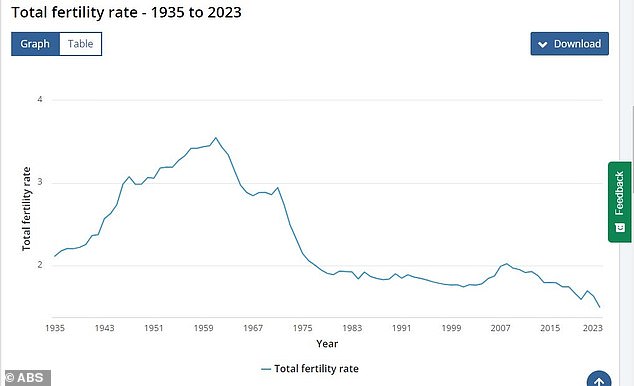Expert reveals simple reason why Australia’s fertility rate has plummeted to an all-time low
Australia’s fertility rate has fallen to an all-time low as a growing number of couples and women decide to have children later in life.
In 2023, 286,998 births were recorded in Australia, a four percent decline from the 300,684 recorded in 2022, giving a fertility rate of 1.5 babies per woman, also down from the previous low of 1.65 in 2022.
It was the lowest number of births since 2006, when Australia’s population was at least two million fewer.
The average age of an Australian mother has risen to 31.9 years, unchanged from the same high water mark reached in 2022, according to figures released on Wednesday by the Australian Bureau of Statistics (ABS).
Peter McDonald, emeritus professor of demography at ANU in Canberra, said the long-term trend pushing down birth rates – which have fallen since a peak of 3.5 in 1961 – was that expectant parents were delaying their pregnancies.
“That has been gradually bringing down the Australian birth rate for 50 years, with some bumps,” Professor McDonald told Daily Mail Australia on Wednesday.
“Younger people have established themselves in their careers and postponed life and established themselves, staying longer in education, traveling and all these things lead to things happening later.”
He said governments should be concerned if the lower fertility rate is not caused by people’s intentions, but because they cannot.
Australia’s fertility rate has fallen to an all-time low, according to new Australian Bureau of Statistics figures released this week (stock image)

Australia’s fertility rate has fallen since it peaked at 3.5 babies per mother in 1961 (pictured is a graph of the fertility rate from 1935 to 2023)
“We cannot delay births until women are in their 40s or there will be no births,” he said.
Professor McDonald said that when women delay having children it means they tend to have fewer babies.
“What falls is that women have three, four, five children, not an increase in the number of women who have no children, but that is always possible,” he said.
The professor said there are two policy tools that governments can use to increase fertility rates.
“One is affordable housing and the other is affordable child care,” he said.
“It takes a lot of time to create affordable housing, but they could also arrange affordable childcare.”
Despite the Albanian government investing $5.4 billion in subsidizing cheaper childcare, Professor McDonald says there is still room for improvement.
‘The Productivity Commission recently released a report calling for more support for childcare. “I wouldn’t be surprised if the government or even the opposition moved in that direction,” he said.

However, Professor McDonald said that in Australia the intention to have children had remained stable over the past 50 years (stock image)

ANU emeritus professor of demography Peter McDonald (pictured) said governments had reason to worry if parents who want children could not have them
The biggest warning sign that there may not be enough children to replenish the aging population is a change in the number of women choosing not to have children, Prof McDonald said.
Japan and South Korea are countries where a large proportion of women are childless, with approximately 30 percent of Japanese women not giving birth during their childbearing years.
However, Professor McDonald said in Australia the intention to have children had remained stable over the past 50 years.
“It may be economically difficult to have children, but many people really want children,” he said.
“Although people want to have children as part of their lives, they will do so despite some economic hardship.”
Professor McDonald said Australia’s overall birth rate was boosted by migration, but not because of a higher fertility rate.
“Births remain at high levels in Australia because migrants are of childbearing age (between 25 and 40 for women),” he said.
“It is not because migrant women have more births than those of the native population, but because they contribute to the birth population.”
